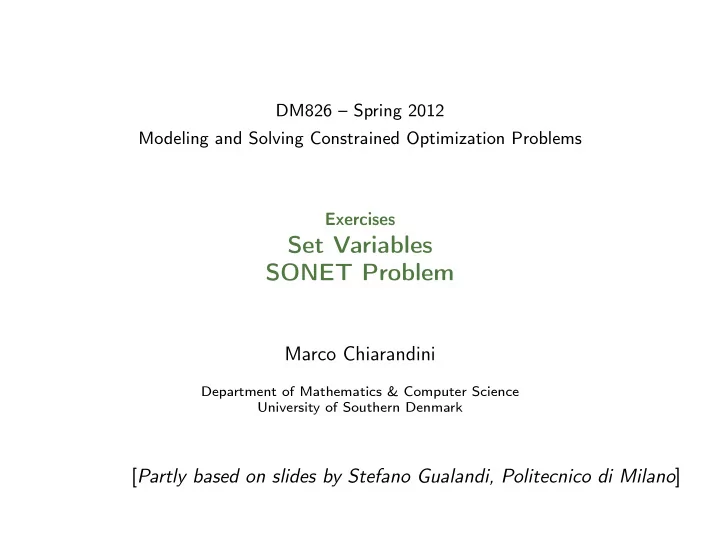

DM826 – Spring 2012 Modeling and Solving Constrained Optimization Problems Exercises Set Variables SONET Problem Marco Chiarandini Department of Mathematics & Computer Science University of Southern Denmark [ Partly based on slides by Stefano Gualandi, Politecnico di Milano ]
Sonet problem Optical fiber network design Sonet problem Input: weighted undirected demand graph G = ( N , E ; d ) , where each node u ∈ N represents a client and weighted edges ( u , v ) ∈ E correspond to traffic demands of a pair of clients. Two nodes can communicate, only if they join the same ring; nodes may join more than one ring. We must respect: maximum number of rings r maximum number of clients per ring a maximum bandwidth capacity of each ring c Task: find a topology that minimizes the sum, over all rings, of the number of nodes that join each ring while clients’ traffic demands are met. 2
Sonet problem Sonet problem A solution of the SONET problem is an assignment of rings to nodes and of capacity to demands such that 1. all demands of each client pairs are satisfied; 2. the ring traffic does not exceed the bandwidth capacity; 3. at most r rings are used; 4. at most a ADMs on each ring; 5. the total number of ADMs used is minimized. 3
Sonet : variables Set variable X i represents the set of nodes assigned to ring i Set variable Y u represents the set of rings assigned to node u Integer variable Z ie represents the amount of bandwidth assigned to demand pair e on ring i . 4
Sonet : model � min | X i | i ∈ R s.t. | Y u ∩ Y v | ≥ 1 , ∀ ( u , v ) ∈ E , Z ie ∈ { 0 , d ( e ) } , ∀ e ∈ E , Z i , ( u , v ) > 0 ⇐ ⇒ i ∈ ( Y u ∩ Y v ) , ∀ i ∈ R , ( u , v ) ∈ E , u ∈ X i ⇔ i ∈ Y u , ∀ ∈ R , u ∈ N , | X i | ≤ a , ∀ i ∈ R � Z ie ≤ c , ∀ i ∈ R . e ∈ E X i � X j , ∀ i , j ∈ R : i < j . 5
✞ ☎ from numpy import * from gecode import * Rings = range(4) # upper bound for amount of rings Nodes = range(5) # amount of clients demand = array([[0,1,0,1,1], [1,0,1,0,0], [0,1,0,0,1], [1,0,0,0,0], [1,0,1,0,0]]) capacity = [3,2,2,3] # capacity in nodes of possible rings X = map(lambda r: m.setvar(intset(),0,len(Nodes),0,capacity[r]),Rings) #nodes for r Y = m.setvars(len(Nodes),intset(),0,len(Rings),0,len(Rings)) # rings for u # at least two nodes in each ring for r in Rings: cardinality(X[r], IRT_NQ, 1) # implied constraint for (n1,n2) in combinations(Nodes,2): IntVar z(intset(),0,4,1,len(Rings)); if demand[n1,n2]==1: rel(Y[n1], SOT_INTER, Y[n2], SRT_SUP, z) channel(X,Y) IntVarArray z(len(Rings), ) for r in Rings: cardinality(X[r],z[r]) IntVar adm(0,len(Rings)*len(Nodes) linear(z, IRT_EQ, adm) ✝ ✆
Once a variable X[i] has been chosen, we first try to include the node that has the most communication with the nodes already placed in ring i , ✞ ☎ while (!and(i in Rings)(X[i].bound())) { selectMin (i in Rings: !X[i].bound())(X[i].getCardinalityVariable().getSize()) { set{int} S = X[i].getPossibleSet(); set{int} R = X[i].getRequiredSet(); Solver<CP> cp = X[i].getSolver(); selectMax (e in S: !R.contains(e))(sum(n in R)(demand[e,n])) { try<cp> cp.requires(nodesInRing[i],e); | cp.excludes(nodesInRing[i],e); } ✝ ✆
References 8
Recommend
More recommend